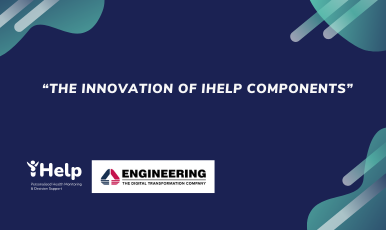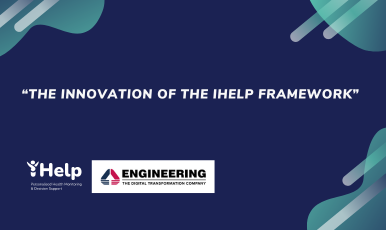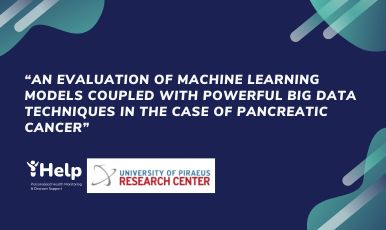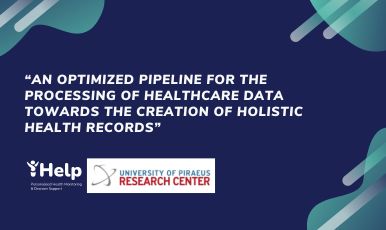It has been established that the importance of public opinion on social media platforms has become significant in recent years and especially with the impact of the COVID-19 pandemic there is a surge in public opinion and narrative building based on discussions held on social media. This unprecedented rise in social media engagement prompted the researchers to realize that the policy-making process could benefit from integrating this publicly available, user-generated data through the techniques of Social Media Analytics.
Social Media Analytics gathers data from different social media platforms to analyze the lifestyle and societal trends/ behaviors to provide conclusions that would enable the policy-maker to take actions to enhance the efficiency of a healthcare intervention or activity. The aim of social media analysis within the scope of the iHelp project is to provide an additional stream of analysis to the policy-makers as assistance in the policy-making process. The Social Media Analyser tool developed by ICE (iHelp Consortium Partner) will help the policy-makers gather and analyze streams of social media through multiple platforms (Twitter, Reddit, Facebook, etc.) and draw meaningful information that would help in creating a new policy or improve on the existing ones. The social media analyzer tool will apply state-of-the-art techniques e.g., Complex Event Processing (CEP), Sentiment Analysis (SA), and Natural Language Processing (NLP) to the gathered datasets collected from the social media posts and present the results. These results will be furnished on an intuitive dashboard integrated within the project to draw significant conclusions that will assist policy-makers to create policies regarding Pancreatic Cancer.
How does it work?
The user of this tool is enabled to create multiple functionality modules known as applications, which run simultaneously and extract Open-Source Intelligence (OSINT) and generate alerts based on the criteria defined, at the time these applications are set up. The tool applies state-of-the-art technologies and extracts meaningful information by using CEP techniques and analyses the post to identify keywords and generate alerts. The overall functionality is then supported by the NLP to understand the meaning and SA to measure the sentiment and subjectivity of a particular post. It also enables the user to apply multi-layered conditions based on up to two lists of keywords, uploaded in the system.
The results acquired by the application are furnished in a Graphical User Interface (GUI) which has been designed to provide maximum information to the user. The results will be furnished in the form of charts and graphs for better understanding for non-technical users such as policy-makers. This allows the user to draw actionable results and conclusions. The GUI will be embedded with informational widgets such as:
- Heatmap
- Regional breakdown
- Daily/Total Alert count
- Age and Gender demographics
This would enable an application to provide an overall picture within the scope of the topic of interest. The user will be able to somewhat gauge the public sentiment about the topic by using the overall results collected through the multiple applications running.
Running multiple applications with different criteria and topics of interest, that yield actionable information on multiple topics, allows the policy-maker to create an overall scenario about the public perception regarding a healthcare policy or intervention.
Based on the research and discussions during the development of this tool, it was realized that Social Media Analyser would require some new functionalities to make it a robust and strong tool to create an impact that would help the policy-makers. As the tool strives to gather Social Media Intelligence (SOCMINT), it is important for it to possess the capability to penetrate further into social media discussions to understand the societal factors that affect and influence public perception of a healthcare policy. The social media analyzer tool monitors social media posts and captures the publicly available details of users. The system identifies the social media platform users who are visible and engaging within their network in the context of the topic of interest. These users are recognized as “Influencers”. The “influencer” in the context of the iHelp project would be anyone who is creating an impact by attracting attention from other users on the social media platform.
The influencers can further be approached and used in some capacity to disseminate awareness/ information regarding any existing or new policies rolled out. These influencers can become effective intermediaries to advocate the policies or information about the healthcare intervention around Pancreatic Cancer.

Conclusions
As mentioned earlier, the social media analyzer tool will be used to provide assistance to the policy-maker in creating new or improve the existing policies regarding Pancreatic Cancer, in view of public sentiment and perception. There is evidence that public administration bodies around the globe are adopting web tools such as blogs, microblogging, and social media to obtain crowd-sourced information to shape their healthcare activities and interventions to make them relatable to the general public.
Using social media analytics effectively would also help in countering propaganda and fake information regarding healthcare activity. Policy-maker can cross reference the information prevalent on social media with the correct information and can design information dissemination activities to counter the false narrative.
The Social Media Analyser can prove to be a specialized asset in the healthcare industry and can be used for the betterment of the health policy-making process. The tool is recommended to be released as an open-source resource with the flexibility of modification so that it can be used in industries beyond healthcare.






